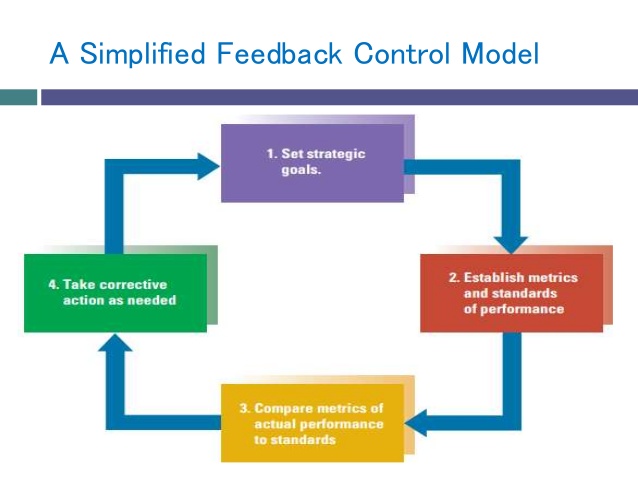Feedback Control Model
All effective control systems involve the use of feedback to determine whether organizational performance meets established standards to help the organization attain its goals.
Managers set up systems for organizational control that consist of the four key steps in the feedback control model as illustrated in Figure X5.
 Figure X5 | A Simplified Feedback Control Model
Figure X5 | A Simplified Feedback Control Model
|
The cycle of control includes
- setting strategic goals for departments or the organization as a whole,
- establishing metrics and standards of performance,
- comparing metrics of actual performance to standards,
- and correcting or changing activities as needed.
For example, a goal for the Hershey CompanyOpens in new window is to have Hershey’s KissesOpens in new window “looking as great as they taste,” said spokesman Jeff Beckham. Feedback from customers alerted Hershey to a deviation from standards.
Bakers who were using the popular candy to adorn their holiday cookies were furious to find bags full of Kisses that were missing the tip on each piece of chocolate. “They baked ok but not with the nice pointy tip that I’m used to or expect from Hershey,” one customer wrote in a blog post. “I’m still steaming!” Hershey executives are taking the matter seriously, said Beckham, exploring what went wrong and how to make sure all Hershey’s Kisses come out looking the way they should. Feedback control helps managers make needed adjustments in work activities, standards of performance, or goals to help the organization be successful.
Managers carefully assess what they will measure and how they define it. At Sprint Corporation, a new CEO discovered that the company was struggling because managers were measuring the wrong things.
For example, managers in the customer care department focused on metrics that controlled costs but didn’t solve customer problems. Consequently, Sprint had a terrible customer service reputation, was losing customers, and wasn’t meeting its financial targets.
A new CEO came on board and told managers to stop worrying about how long it took for a care agent to handle a call and start focusing on how effectively the agent solved the customer’s problem.
Before long, Sprint had moved way up in the consumer satisfaction ratings and was adding new customers. Managers at most companies, like Sprint, use a number of carefully focused operational metrics to track performance and control the organization rather than rely on financial measures alone.
Managers in many successful companies, including Google, Intel, and the Gates Foundation, use a system that relies on OKRs (objectives and key results). OKRs establish the target the organization wants to achieve and the results that help benchmark and monitor how it reaches them.
OKRs are set for all important areas of the business, and managers track metrics in such areas as customer satisfaction, product quality, employee commitment and turnover, operational performance, innovation, and corporation social responsibility, for example, as well as financial results.
You Might Also Like:
- Daniel R. Denison and Aneil K. Mishra, “Toward a Theory of Organizational Culture and Effectiveness,” Organization Science 6, no. 2 (March–April 1995), 204-223.
- Robert E. Quinn, Beyond Rational Management: Mastering the Paradoxes and Competing Demands of High Performance (San Francisco: Jossey-Bass, 1988).
- Mohamed Hafar, Wafi Al-Karaghouli, and Ahmad Ghoneim, “An Empirical Investigation of the Influence of Organizational Culture on Individual Readiness for Change in Syrian Manufacturing Organizations,” Journal of Organizational Change Management 27, no 1 (2014) 5–22.
- Harrison, Michael I. 2005. Diagnosing Organizations: Methods, Models, and Processes. Thousand Oaks, CA: Sage Publications, 29
- Scott, W. Richard, and Gerald F. Davis. 2007. Organizations and Organizing: Rational, Natural, and Open Systems Perspectives. Upper Saddle River, NJ: Pearson-Prentice Hall, 78.
- Jr. 2002. Organization & Management Problem Solving: A Systems and Consulting Approach. Thousand Oaks, CA: Sage Publications, 20.

